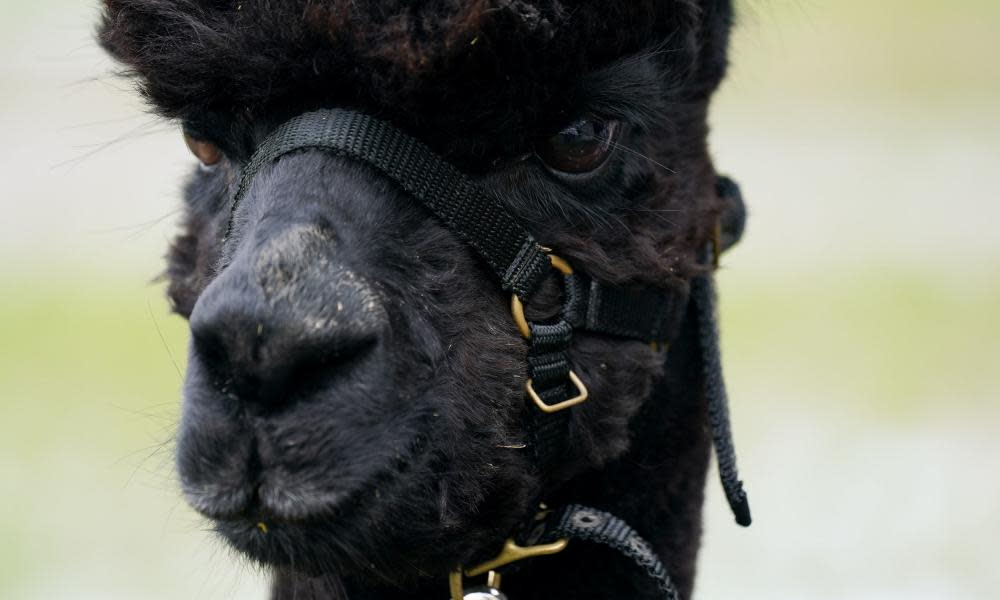TB or not TB? Why Geronimo the alpaca has divided experts

Long-necked, mop-headed and allegedly “a bit grumpy”, Geronimo the alpaca may seem an unlikely cause célèbre.
Yet the future of the eight-year-old camelid has divided experts, stirred some tabloids into indignant fury, and provoked campaigners – known as “alpaca angels” – to march through London.
Their anger is aimed at the ruling that he must be put down – because he has twice tested positive for bovine tuberculosis. They want him saved. Others insist there’s no choice – his time is up.
It’s a story that would be easy to dismiss as a silly season staple, but there are important issues behind the headlines.
According to government figures, 28,356 animals were slaughtered due to a TB incident in England in the 12 months to March 2021, with 205 camelids culled in 2020.
None have gained the same attention as Geronimo – TB controversies have previously focused on the culling of badgers to prevent the spread of the disease, a practice some scientists have criticised but farming unions have said is necessary.
But the fate of Geronimo has shone a light on a pathogen that experts say is one of the greatest animal health threats to the UK, costing taxpayers about £100m every year.
Bovine TB is caused by the bacterium Mycobacterium bovis, and can occur in a range of species, including badgers and camelids – such as alpacas. A zoonotic disease, it can also be passed to humans, although in the UK this is now rare thanks to measures including milk pasteurisation and compulsory tuberculin testing of cattle herds, together with culling of infected animals.
“Although the risk to humans is currently very low, that is because all these controls are in place,” said Prof Rosie Woodroffe at the Zoological Society of London, who is an expert on badgers and TB. “As recently as the 1930s, tens of thousands of people were dying each year from bovine TB, and at that time about 40% of cattle had the disease, and milk wasn’t pasteurised.”
While the prevalence of bovine TB declined until the end of the 1970s, it subsequently stalled before rising. “We now have TB spreading again, particularly up the west side of England and south Wales,” said Malcolm Bennett, a professor of zoonotic and emerging disease at the University of Nottingham.
Testing for the disease varies between species. For cattle the situation is rather like the skin test for TB in humans: purified proteins from bovine TB are injected into the neck of the cow.
If a lump develops, this is indicative of infection.
But because some other mycobacteria, which are not of such concern, can also result in a reaction, the cow may also be injected with proteins from these.
“The two reactions are compared – literally by measuring a skin swelling at the injection sites – and if the difference is above a threshold, the animal is declared positive [for bovine TB],” said Prof Rowland Kao, an epidemiologist at the University of Edinburgh who is a member of Defra’s Science Advisory Council and bovine TB partnership.
“These tests are generally poor sensitivity – [they] miss lots of positives – but high specificity,” Kao added. In other words, they rarely say a negative is positive.
If the test comes up positive, those cattle are culled.
However, as Kao points out, most of the data for the tests is on cows – although there is some on camelids.
Prof Ian Jones of the University of Reading said the test was not perfect. “There is a question mark over how big a lump you need in order to score it as a definite positive which has led to the development of several alternatives” he said.
According to Bennett, the skin test does not work well on camelids, deer or badgers. Instead antibody tests are used.
But as antibodies do not reach high levels until the disease is advanced, the animal may be first given a dose of bovine TB proteins 10-30 days before the test, which will amplify antibody levels – provided an immune response already exists as a result of an infection.
Jones said there were questions around accuracy and how applicable such tests were between species.
In Geronimo’s case, the Enferplex antibody test was used. According to Defra, this has been specifically developed and validated for alpacas with the chance of a false positive result just 0.34%.
Defra notes Geronimo was twice found to be positive using this approach. “Geronimo tested positive and had antibodies to four different types of the TB antigens in response to the TB bacterium,” Defra said.
One issue with Geronimo, Bennett said, was that it seemed the alpaca had been given skin tests in 2017 prior to arriving in the UK and having antibody tests.
“[Some would argue] there is a big difference between … giving one dose of tuberculin [TB proteins] and then looking for antibodies to improve the sensitivity, and giving three or four doses and then getting an antibody response,” he said.
However Defra has denied this. “The injection of tuberculin does not induce a false positive antibody response in animals that have not been exposed to the bTB bacterium in the first place,” they say, noting tuberculin does not build up in animals and that uninfected animals will not have antibodies to bovine TB.
Fundamentally the fact is that bovine TB is controlled on a population level and, as Jones notes, the premise is to err on the side of caution and destroy an animal even if a positive test is borderline.
“This is made all the more difficult and emotive when you are dealing with individual animals and your policy involves culling,” said Bennett. “Of course vaccination would be far better – and that is coming.”

 Yahoo News
Yahoo News 
